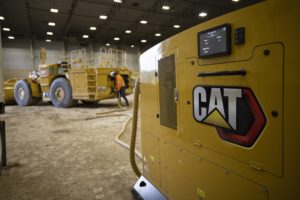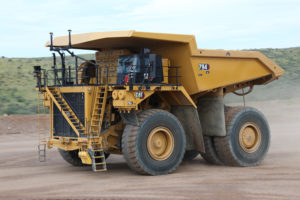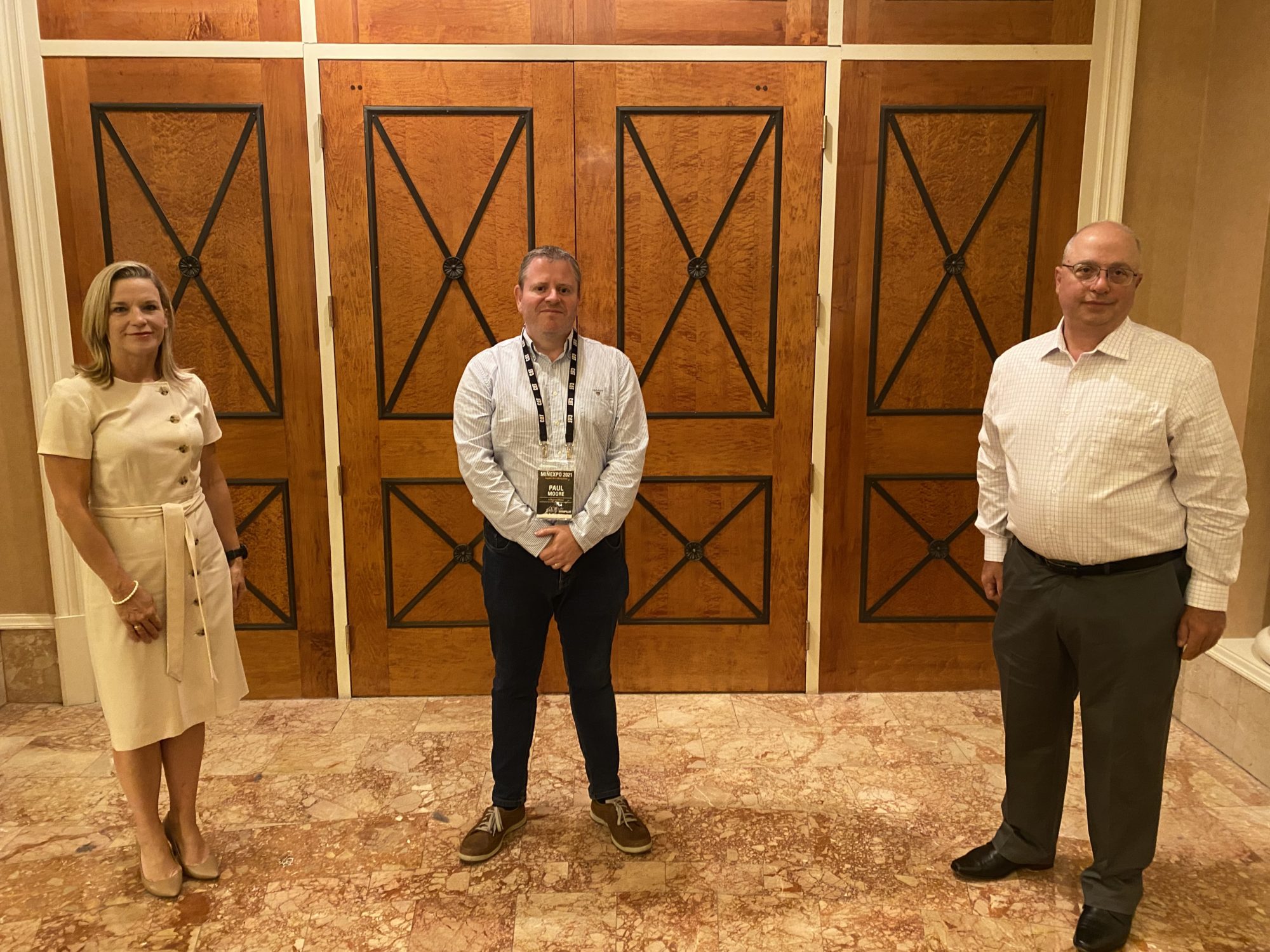As MINExpo 2021 opened, Paul Moore sat down with Denise Johnson, Caterpillar Group President, and Brian Weller, Chief Engineer and General Manager, Resource Industries Electrification, talking everything from helping customers hit carbon reduction targets to the challenges and opportunities of combining battery haulage with autonomy
Has the speed at which mining companies are looking to cut their Scope 1 emissions, with significant fixed reduction targets by 2030, taken Caterpillar by surprise?
DJ: We have been talking for a number of years to the mining companies about zero emissions targets over the longer term but with no hard dates established at the time we started talking. There have been several related initiatives since then – notably the ICMM’s Innovation for Cleaner, Safer Vehicles (ICSV), that has involved the major OEMs including ourselves as well as a number of the major mining companies. These initiatives have looked at GHG reduction but also areas like collision avoidance and DPM reduction underground. But the crystallisation of fixed dates you mention from the major mining houses over the last 12-18 months created much more of a roadmap to which we had to put hard development targets on – and also I think accelerated our roadmap. It gave us more clarity on the path forward and when you make commitments to investors as these companies have, they have to deliver on those reductions. Then you start to break down what pieces make up that reduction – and its not just mobile equipment – but certainly for most large mining sites, the big trucks are a meaningful portion, particularly when just looking at Scope 1 emissions. Then you start to focus in on what is it that needs to change first and you can prioritise the development process.
Your recent agreement with BHP focuses on battery truck development – are you still taking an agnostic future powertrain approach? And the statement said they will have early access to Cat zero emissions equipment – can you expand on what that means?
BW: When you’re evaluating new machines and technology platforms, you have to understand your site energy source. We have done enough analysis that has shown that the solution is highly dependent on the individual project and site in terms of the machines being used and the application. There are project examples where running a hydrogen fuel cell powered fleet represents the best value in terms of competitive TCO. But I could take the same truck for a different application in a different part of the world, and this is no longer the case. So the solution you will see will have different energy sources depending on the product and where it is going to go. There are examples where fuel cells will be a higher cost to run than battery electric and vice versa.
DJ: Infrastructure is the big variable. A particular project may be in a part of the world that does not have access to renewable energy or even access to a grid. They may have a different energy profile for the minesite itself that lends itself to a particular mobile fleet power source. Plus the cost of energy changes from region to region.
BW: On power agnostic if you mean that we are open to a number of future power solutions – battery and hydrogen being two, but also others – then yes we are open to multiple options depending on what the customer needs. The customers are on what I like to call a glide path. They have a stack of carbon generating sources – everything from forklifts in the maintenance shop to the conveyors and the trucks. Every single minesite has to look at where carbon is being produced and then decide over time when to replace it and with what technology. That recipe is very unique to that site, location, asset base and life of mine.
DJ: There are also examples where customers are using bio fuels today to get them part of the way to their interim carbon reduction goals.
BW: On the early technology access point, with emissions reduction, we like to refer to four parts – people, process, infrastructure and technology. The infrastructure part is so significant in terms of the learnings that have to happen within a minesite, it is almost as large as those for us on the truck development side whether you are talking about safety protocols, how you will charge, how you will deal with energy swings. So given this, it makes sense for mining companies to have access to early machines so that they can begin making that journey.
DJ: With the exception of a few early pilot units, we traditionally would wait until we are in factory production before putting iron on a customer site. This is going to be a little different – because of the significance of the infrastructure issue. But autonomy also required major change management and learnings which was achieved – and this will be the same. Doing this together with the mining customers allows us both to learn together and to learn faster.

Can Stage V engines, trolley assist, dual fuel and other approaches give customers the medium term emissions cuts they are looking for before we get to all battery trucks for example?
BW: It goes back to the customer glide path and the right recipe for carbon reduction that is very site specific. One customer may have an application where they can put trolley in effectively, another may not – it is very site specific. The same applies to biofuels and LNG. This is why you are seeing so much variation in how mines are proceeding because the solution is often so unique to a project and site. And saying that one technology will get the whole industry there is unrealistic. It is more a series of steps that will be taken. Look at electric shovels – most diesel hydraulic shovels today have a tethered electric option. And more customers are now looking to use that. I would say the technologies you mention are not just an interim step – they are part of the zero engine emissions pathway. On Stage V engines, it is important to clarify these are mainly reducing things like NOx and PM – whereas something like battery or trolley is very focused on carbon reduction.
How do we make things like battery charging compatible with autonomous mining?
DJ: Actually this is one of the really exciting parts of showing what technology can do. Think about a traditional truck with a driver – they will look at how much diesel fuel they have and generally, a tank is enough for three shifts or 24 hours. As you move to electric – you need to charge those trucks much more frequently. You are in a position where, depending on where you are on the minesite, you may not get back to a charging station and the truck will get stuck. The layer of technology to know where you are in your battery level as well as where you are in the haul cycle is critical. Technology is the key to optimise battery performance, battery life, and production. And we have conversations every day with mining customers on these sorts of issues. Autonomy is going to be a part of the future for almost all major mines as well as many of the smaller ones, so it will go hand in hand with electrification.

You have gone with a mobile charger strategy with underground equipment – are you also looking to mobile options for surface mining?
BW: Absolutely – because the face of the mine is constantly moving, so you will have to move the chargers at some point. Some mines may also look to battery charging via trolley. There are a number of methods including static or dynamic charging. With trolley charging of a battery, you are using it either to displace the energy running through the battery or for charging the battery. It is just a question of how am I getting energy on board and if there is an opportunistic way to do it, then mines will do it. But remember, with trolley you still have to put that infrastructure in with substations and cabling. The mobile chargers will be the same and fast charging to keep these trucks running will require significant energy so substations will be needed here too. Think about the cabling and substations that work today with large rope shovels which have to be moved – this will happen with truck chargers too.
Will robotic charging also make sense in terms of autonomy extension?
BW: You want the charging to be safe, fast and efficient. If a robotic arm or other similar system can be made to work efficiently then of course it would be preferred – in the same way some mines are already running robotic diesel fuelling today.
Does Caterpillar have a prototype all battery truck or FCEV truck running today at your test facility?
DJ: Talking underground – we have battery electric R1700 XE units running right now at customer sites. On large mining trucks, we have significant development work underway and will have customers to the Tucson Proving Ground next year to see our integrated solutions in person, including prototype large mining trucks.
BW: Caterpillar’s design philosophy is to do a lot of analysis and simulation first. Then we do the component level. Actually, putting the truck together isn’t the hardest part. We are spending very significant time on software, components and systems.
Do you see a period during which “new power” trucks will have to coexist with conventional trucks as new technology is phased in?
DJ: Aside from some greenfield projects there will be a phased introduction where mines have large existing fleets. So yes, the new power trucks will coexist for some time at many mines with conventional trucks – they will be “feathered in” if you will.
BW: Coming back to the infrastructure point – it is such a big part of this. The customer may say we have the capability to run a certain number of all electric trucks today based on the site energy profile. They may want to run them in a particular part of the mine first – which is common with autonomy introduction but in the case of electric, they may do it, so they don’t have to have a lot of chargers in the main part of the mine from the outset.
Will fleet management systems have to change to allow for new power trucks?
BW: Of course, and we have the intention to do that with MineStar but also with Command for hauling. Think about the amount of information you are going to need from a battery powered truck for example. We like to talk about the ACE concept – autonomy, connectivity and electrification. There is no point in coming up with a spot solution for one small part of it. The technology allows us to do things we could never do before when these key technology offerings are fully integrated with the iron. You might have a minesite that has a downhill haul that over time will become a flat haul and then will become an uphill haul from deeper in the pit. Those changes will also change how much energy is used and how it is used depending on where the mine lifecycle is.
DJ: Each site is going to be unique not only in the equipment and power source used but also in the solutions that will unfold relating to ACE. Until now the equipment has been put in and the customer largely decides how to marry it with their mine plan and schedules to optimise the mine. For these new power sites, the approach will be customised depending on the particular recipe that is suited to that mine. They might even have the same hardware, but a different connectivity and software approach – how it is all knitted together.
Will your agreement with Nouveau Monde Graphite be a big step in learning as one of the first greenfield zero emissions mines?
DJ: It’s a really exciting project and we are happy to be leveraging it to help us learn across our organisation. Plus its more than just about the mobile equipment at this site – we are also bringing in a lot of solutions to support the infrastructure from our Energy and Transportation segment. It is a hydro powered project, so it is all renewable. How do you make sure that all the energy transfer across the site is done in a way that allows them to optimise their mining processes? So we are really leveraging a broad section of the Caterpillar company – beyond just the mining specific part, to provide holistic solutions for NMG. And we see that as a real competitive advantage versus other OEMs.
What’s your current view on the market moving to “swarms” of smaller trucks with the focus moving away from ultraclass? And what about going cabless?
DJ: We run a lot of simulations on the tradeoffs between truck size classes. When evaluating larger fleets of smaller trucks as a viable alternative – it is very dependent on how the mine is set up. For a brownfield mine that has traditionally run 400 ton class trucks, putting in swarms of small trucks is probably not going to align with the loading tools in place – the mine hasn’t been designed around smaller trucks. If you are starting from scratch with a greenfield mine and you optimise the mine based on smaller trucks then potentially it could be the lowest cost, most productive solution. But you have to look at it site by site.
BW: That’s right, and it is also highly dependent on the material you want to move – think about the size of the rock – what’s the rock fragmentation like? What is the bench height? What type of rock formation do I have? What is the ration of ore to waste? When you really think about what’s the right size truck – and that’s a question we get all the time – there’s over 40 variables you have to think about. There is a right size truck – but its for that site.
DJ: On cabs, I do see cabless coming in the future. Currently one reason for keeping the cab is to allow the autonomous truck to be driven manually, like around a truck shop. But there are other ways of moving the truck such as with remote devices. And when you think about the weight of the cab and the complexity of providing all the features for the operator environment – if you know the future is going to be all autonomous then eventually you get there with no cabs. It’s just the transition time.
Do you see a future of autonomous mining shovels and does Cat have an active program in this regard?
DJ: We do have development of teleoperated and autonomous shovels ongoing and its part of our roadmap, but it hasn’t been a priority for our customers. In addition, we look at what advantage does it bring from a productivity perspective. It has potential from a safety perspective – some shovels operate in more challenging conditions. But because automation in other areas drives a much higher return for the customer, we have focused our development on our customer’s priorities. Take, for example, the autonomous water truck we are doing right now with Rio Tinto at Gudai Darri. Optimising water delivery improves productivity while reducing overwatering. For shovels, our focus has been more around operator assist and getting the semi autonomous advantage from the shovel movement in and out of the face.
Do you see autonomy moving more towards onboard edge computing and AI – where the trucks become more able to react to situations themselves?
DJ: We already have a significant amount of computing power on the truck and continue to make updates to our existing platform. We are also making investments in additional platforms for autonomy. It is a combination of bringing more value onto the machine but also considering cost. We want to hit the sweet spot of faster computing, plus have more peer-to-peer machine interaction as well.











